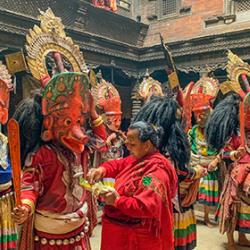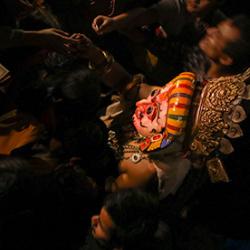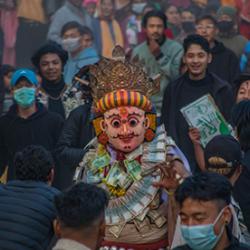Devi Chakrabarti: The Afterlives of a Disaster: Post-Earthquake Reconstruction and Spiritual Life in Bhaktapur, Nepal
Photo 1: Worshipping the Living Nava-Durga Masks at the Sanctum
The members of the Banmala community at the Nava-Durga sanctum in Bhaktapur, wear the masks of the Nava-Durga, or the nine dangerous deities, who are demonic incarnations of the Hindu Goddess Parvati known to protect the city from violence, disasters, and disease. The Banmala community are considered a low-caste group in Bhaktapur who traditionally engaged in flower-selling and farming and are the sole keepers of the Nava-Durga tradition. In this photograph, the dancers are preparing to perform on the streets of Bhaktapur, as part of their annual cyclical ritual which lasts for nine months and is the longest running festival in Nepal. Before the dancers depart for their performances, the masks are worshipped by the Nakin, or the female head of the community, who is also the caretaker of the Nava-Durga sanctum. The masks have esoteric symbolism unknown to non-initiates and wearing the masks allows members of the Banmala community to transcend social hierarchies and embody the living goddesses
Photo 2: Pursuing the Dancer turned Deity
The mask-clad dancer is surrounded by devotees as he performs a dance-drama on the streets of Sanga, a village located in the East of Bhaktapur. The dance-dramas are often satirical, based on folk tales of Bhaktapur, and intend to carry a strong social message. Here the devotees are seen in a state of frenzy, thronging the dancer turned deity, offering him money and food, taking photographs and jostling each other only to gain proximity to the dancer. Despite the fear-provoking nature of their performance, and the startling appearance of the masks, devotees happily engage with the Nava-Durga dancers, and seek their blessings since they believe it is an opportunity to interact with corporeal forms of the divine, who will in turn protect them from obstacles.
Photo 3: Playing with the Living Gods
In this photograph, devotees, typically young men are seen chasing the Seto-Bhairav deity, embodied in the dancer wearing the mask, who circumambulates the locality, playfully mocking the devotees. This ritual is intended to entertain people but often leads to aggressive hounding and rowdiness. In this act, the dancer representing the deity, is fishing, and the devotees symbolise fishes who tease the deity and run to prevent being caught. At the end of this game-like ritual, the young men who participated, offer the masked dancer alcohol, and it is believed that the dancer’s capacity to intake copious amounts of alcohol miraculously increases during the period of the Nava-Durga festival. Engaging with the devotees playfully is believed to be the Nava-Durga deities’ way of expressing affection towards them and is a central part of the festivities.
What the Judges said of Devi's images:
'Captivating, colourful, and dynamic pictures of different masked figures (although, it seems from a single event), variety in composition. Three stunning images, particularly 2 and 3.
Image 2 leads well into image 3. Image 2 piques our interest with the angle from above looking down, leading us into image 3 that offers more context, depth, and a better sense of place and scale for the event. The light illuminating the mask in image 2 is breath-taking, coupled with the movement of event attendees in the shadows surrounding the masked individual. Image 3 features strong depth of field and the subdued colour palette is gorgeous.
The accompanying text is clear and detailed. Wonderful standalone images, lots of movement and atmosphere conveyed. Interesting bird’s eye view shot and use of focus in the second image, striking facial expressions in the third image especially in contrast to front-on shot of the dancer/deity.'



